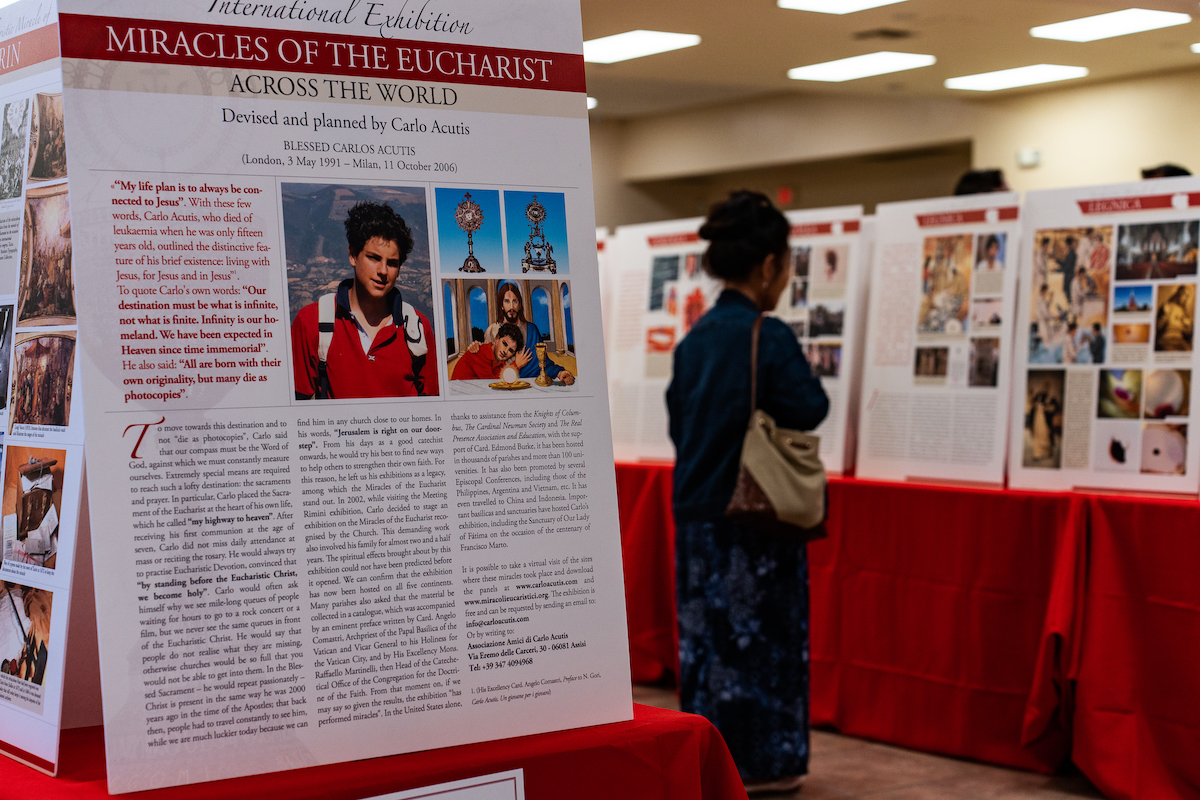By Jeff Grant, The Catholic Sun
MESA, Ariz. — For Catholics, there is be no more fundamental aspect of their faith than the moment of transubstantiation. During Mass, at the Eucharistic prayer, the consecrated bread and wine become the actual body and blood of the risen Christ. Worshippers then receive that body and blood minutes later when they take Holy Communion.
“The Eucharist is ‘the source and summit of the Christian life,’” states paragraph 1324 of The Catechism of the Catholic Church.
“The other sacraments, and indeed all ecclesiastical ministries and works of the apostolate, are bound up with the Eucharist and are oriented toward it. For in the blessed Eucharist is contained the whole spiritual good of the Church, namely Christ himself.”
However, results of a study conducted by the Pew Research Center three years ago found a majority of Catholics believe the host and wine to be only symbols of the risen Christ.
“It breaks my heart that as Catholics we are to believe in the real presence, and so many don’t,” lamented Angeline Osorio of Holy Cross Parish in Mesa. Osorio has assisted the Diocese in bringing to Arizona a Vatican exhibit that has traveled the globe, including the United States, detailing Eucharistic miracles documented by the Church over time.
The exhibit went on display for the first time in the state this past weekend at Holy Cross, and is scheduled to make its way across the Diocese through the rest of the year and into 2023.
“There is a potential for a special kind of wonder,” when viewing the exhibit, said Fr. John Nahrgang, who served as the Diocese’s Vicar of Evangelization until earlier this year and has seen the exhibit at the Vatican. “This is a way for people to become more familiar with the Eucharist and the miracles.”
Created and designed in 2002 by Blessed Carlo Acutis, an Italian teenager and computer whiz who died just over a decade later from leukemia, the exhibit traveling Arizona details 53 of the more than 125 Eucharistic miracles documented by the Catholic Church throughout history. Many of the occurrences are supported through scientific analysis. A printed account – about a 2-3 minute read – of each miracle is available, along with photos and drawings for further explanation.
“They are beautifully put together. There are dozens and dozens of witnesses’ [accounts],” Osorio noted.
The list of miracles spans more than 13 centuries, beginning with the first documented occurrence in Lanciano, Italy, in 750 AD through an account from Legnica, Poland, in 2013.
“It was amazing,” exclaimed David Terrill, one of hundreds of visitors. “Growing up, I had heard of some; I had no idea there were so many… and certified by the Vatican. And the fact that some involved multiple happenings in one location, that was quite impressive.”
Sharon Lorenz agreed.
“I knew [of some accounts]. I didn’t know there were so many. It’s fantastic,” she said.
“I do believe Jesus is the body, blood, soul, and divinity when we receive Communion. This will make it so much more powerful to me.”
Fr. Nahrgang hopes for similar reactions from others.
“I think that’s where the real power is: the phenomenon of God doing something humans cannot do. It opens the door to understanding,” he said.
“This is meant to help our belief; make it stronger,” added Fr. Larry Merta, pastor of Holy Cross. “You can look at these things and say, ‘God again is leaving us his calling cards.’”
The display coincides with a U.S. Conference of Catholic Bishops program launched in June to stir Catholics’ awareness of the Blessed Sacrament’s role in their faith. The 3-year National Eucharistic Revival is intended to see “a movement of Catholics across the United States healed, converted, formed, and unified by an encounter with Jesus in the Eucharist — and sent out in mission ‘for the life of the world,’” according to Bishop Andrew Cozzens, chairman of the Committee on Evangelization and Catechesis, who appears on the USCCB’s website.
The Pew Research Center’s 2019 inquiry found nearly 7 in 10 of self-described Catholics believe the consecrated bread and wine are symbols of and not the actual body and blood of Christ. A total of 10,971 people took part in the phone survey. Those over age 60 were most likely to believe in the real presence of Christ in the Eucharist. The only segment reflecting a majority belief were those who attend Mass regularly every week.
Aside from detailing the miracles, the exhibit also gives a glimpse into the inspirational story of its creator.
Described as a boy who liked school and being with his friends, much like any other teen, Carlo had a gift for computers and design. He used those talents and love for Christ to share with the world the significance of the Eucharist and its life-changing power.
Read Carlo’s online biography.
“To always be close to Jesus; that’s my life plan,” he was quoted as saying.
Carlo died of leukemia, a cancer of the blood, in 2006. He was beatified in 2020.
“Blessed Carlo was God’s instrument to bring about this exhibit. I see him as a ‘St. Bernadette,’” explained Fr. Nahrgang. “God uses her as an instrument of his healing through the water of Lourdes, yet she didn’t benefit from it.” Blessed Carlo was God’s instrument to bring this exhibit to show Jesus is alive in the Blood,” he said.
“I’m not a doubter,” said worshipper Kelly Terrill. “The [miracles] have documented real heart muscle, tissue, blood. There’s no explanation for it. It is a reminder that [the host] is truly Christ. It’s not a representation. It’s not a reminder. If you are having any doubts at all, just read about these, and you will see the Eucharist is Jesus… truly present.”







